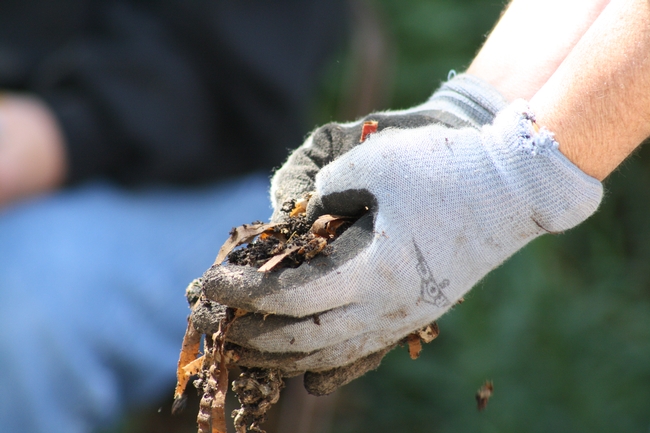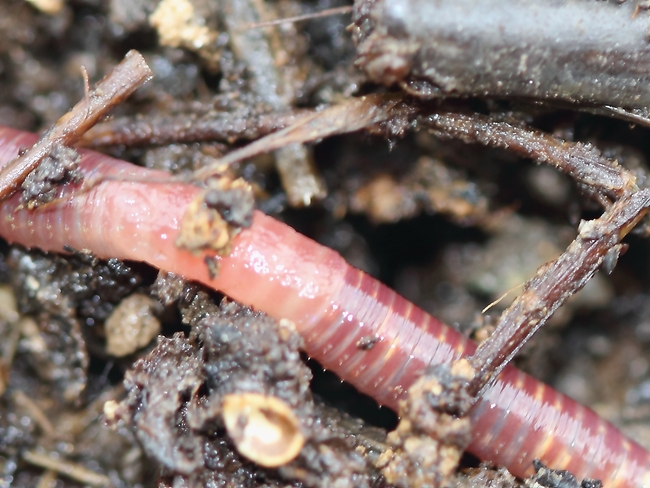
Posts Tagged: compost
Turn food and garden waste into rich fertilizer with worms
UC Master Gardeners in Stanislaus County presented an all-natural, sustainable solution to disposing garden and food waste during a session for the community on worm composting, reported John Holland in the Modesto Bee.
All it takes is an 18-inch deep bin, equipped for drainage, and a supply of red worms. Provide the worms a substrate that contains a mix of high carbon materials - like shredded paper, dry leaves or sawdust - and kitchen scraps - such as fruit and vegetable cores and peels, leftover grains and coffee grounds. A few months later, the worms will have transformed the contents into a rich organic fertilizer ready to be applied to garden plants.
"It's a great fertilizer," said UC Master Gardener Dennis Lee. "It's very inexpensive for you to produce. You can do it indoors. There's very little odor - actually, no odor.
Learn more:
Orange County UC Master Gardeners created a video series on worm composting
Vermicomposting - Composting with Worms, from San Joaquin County Master Gardeners
Build the soil for successful gardening
Before digging in to spring planting, pay attention to building the soil, advises an article in the Los Angeles Times by Jeanette Marantos.
Marantos visited the Pasadena backyard garden of Yvonne Savio, the retired coordinator of the UC Master Gardener Program in Los Angeles County. Savio is the creator of the Gardening in LA blog, with new stories appearing "every other week or so."
“The old saying is, ‘Feed the soil, not the plant,'" Savio said. “When you just use chemical fertilizers, you're not establishing a long-lasting base of nutrition for the plant. It's just giving it a huge piece of cake on Sunday, and then by Thursday it's nutritionally starving.”
Savio recommends a steady diet of organic matter be spaded into soil, and a layer of organic mulch added to the top of soil.
When you continually add organic amendments to the soil, the dirt comes alive as the amendments decompose, creating the beneficial bacteria, fungi and the nutrients plants need to grow strong and healthy, Savio said. “It's really like a cafeteria where your plants can pick and choose what they really like.”
Use compost for water conservation

“Adding compost to your soil on a regular basis increases the amount of water your soil can hold, therefore decreasing the amount of times you need to apply water to your landscape,” says Missy Gable, the director of the UC Master Gardener program, in the final installment of a six-part video series on water conservation in the home landscape.
Compost is organic matter – grass clippings, fallen leaves, spent bedding plants, vegetable peels, coffee grounds, etc. – that has been dampened and turned regularly so it is broken down by worms and micro-organisms. The finished compost, a dark black blend with a pleasant earthy smell, can be mixed into the native soil in the landscape.
Compost improves the soil texture, holds moisture, provides food for beneficial bacteria, and nutrients for plants.
View the video below:
Detailed information about the benefits of compost and instructions for home composting can be found in Composting is Good for Your Garden and the Environment, a UC ANR publication available for free download from the UC ANR publications catalog.
Additional videos in the UC ANR series on saving water in the landscape.
Early-morning watering is best
Remove weeds from your landscape
The videos are also available on the UC ANR YouTube channel.
An initiative to improve California water quality, quantity and security is part of the UC Division of Agriculture and Natural Resources Strategic Vision 2025.
Composting and Water Conservation

To the many benefits of composting, add another: water conservation. When compost is added to bare soils as a thin layer, it is an effective barrier against evaporation of soil moisture, a practice called top- or side-dressing. Compost also reduces plants' needs for water by increasing how much water can be held by the soil - only a 5% increase in organic material quadruples the soil's water holding capacity.1
[A] 2000 study … found that increasing the water holding capacity of the soil by adding compost helped all crops during summer droughts by reducing periods of water stress. The amount of water in … 8 inches … of the compost amended soil increased to 1.9 inches compared with 1.3 inches in un-amended soil. Since vegetables require 1 inch of water a week, at field capacity, the compost amended soil held a 2-week supply of water.2
Compost is the result of a process whereby a large volume of organic matter is rapidly decomposed into a smaller volume that is then used to amend the soil. Soil particles occur in aggregates or clumps, unless they have a high amount of sand particles that do not hold together well. Soil structure refers to the arrangement of sand, silt and clay particles into larger aggregates.3 One can assess the soil structure for their home or community garden by doing the soil-ribbon test and the soils-sedimentation test. This video from Kansas State University tells you how to assess your soil texture by feel. The bottom line is that amending the soil with compost improves its structure, which significantly affects how well it holds water.
Compost is decomposed organic matter that has stabilized, yet, still continues decomposing, though, at a slower rate. The organisms that break down organic matter release glue-like substances that bind soil particles into crumbly aggregates. These irregularly shaped aggregates have air-spaces between them and can be penetrated and occupied by water, nutrients, and plants' roots. Soils rich in organic material have a sponge-like quality that holds water and, thus, plants growing in them have lower water needs.4 In sandy soils with poor water retention, compost improves the soil's water holding capacity by improving soil structure ie., aggregate stability.
Unlike sandy soils, clay soils are characterized by small spaces between the small clay particles. Clay soils have good water retention capacity, however, the spaces in between the particles can fill with water quickly, excluding oxygen and nutrients, and, essentially, drowning the plants. Water saturation in clay soils may also cause soil runoff because those soils cannot hold more water, but, adding compost aerates clay soils and increases its capacity to hold water, oxygen, and nutrients needed for healthy plant growth.
Ultimately, regularly amending with compost lightens clay soils, thus, reducing run-off, and increases the water holding capacity of sandy soils, hence, reducing the need for water. Adding compost as a thin mulch layer over bare soils reduces water evaporation, while also reducing the need for water by garden and farm raised plants. Top-dressing with compost in combination with a thin top-layer of straw mulch in food-growing areas, or a thin woodchip mulch in ornamental garden areas, can reduce plants' water needs around their roots even more, where water is needed the most.
1 Compost Fundamentals, Compost Benefits and Uses. Washington State University, Whatcom County Extension. Accessed on 28 January 2015.
2 M. Charles Gould. Compost increases the water holding capacity of droughty soils. Michigan State University Extension. Accessed on 28 January 2015.
3 Dennis R. Pittenger, ed., California Master Gardener Handbook (University of California Agriculture and Natural Resources, 2002), 36.
4 For the Gardener: Building Fertile Soil. Center for Agroecology and Sustainable Food Systems, University of California, Santa Cruz (Santa Cruz, CA: University of California, no date provided).
Herbicide carry over in compost?
Each of the past several years, we have received samples of tomato plants from small growers and homeowners that have severe leaf deformity. The leaves of affected plants have the following symptoms: the leaves are distorted with cupping and twisting (Photos 1 & 2), as well as strapping or shoe...


